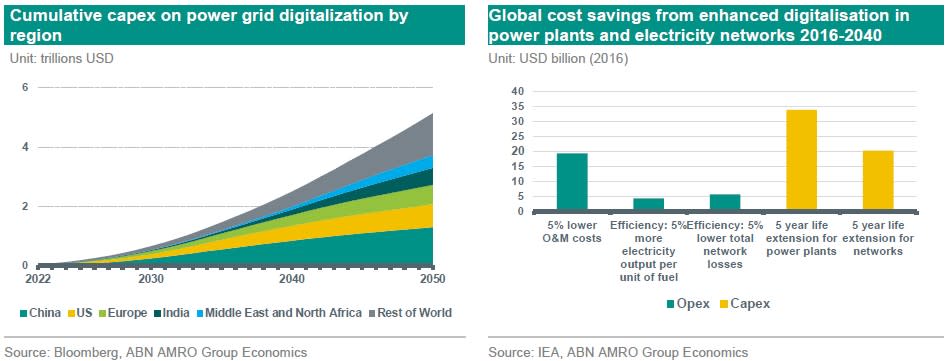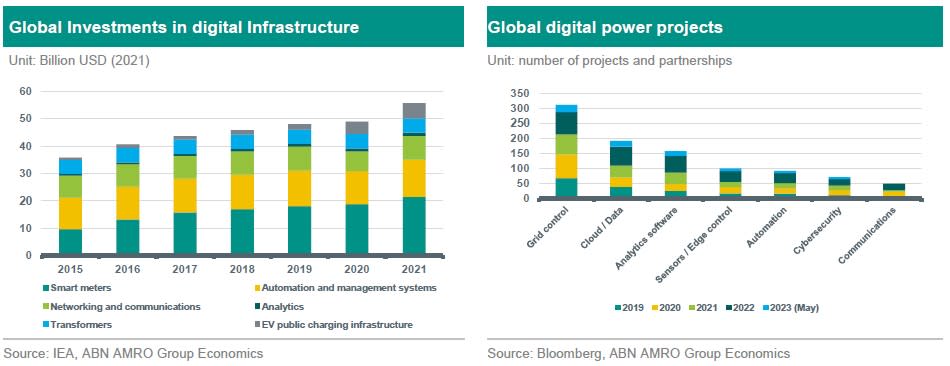SustainaWeekly - Smarter grids for a faster transition

In this edition of the SustainaWeekly, we first focus on the role of smart grids in the energy transition. We dive into the expected benefits of grid digitalization, the smart grid investments trends and we end with some of the challenges associated with the roll out of smart grids. We then go on to look at the International Maritime Organisation’s revised strategy to bring down GHG emissions at a faster pace, comparing the new pathway with existing net zero benchmarks.
Economist: The digitalization of power grids translates into lower operating costs, higher efficiency in electricity production, lower network losses, and extended lifetimes for power plants and networks. However, current levels of investments in grid digitalization need to double through 2030 in order to reach net zero emissions in 2050 and there are also a number of challenges in making the grid smarter, including cybersecurity and privacy.
Sector: The International Maritime Organisation (IMO) revised its strategy to bring down GHG emissions faster. The aim is to reach net-zero GHG emission by or around 2050 by reducing carbon intensity and increasing uptake zero or near-zero GHG emission technologies, fuels and/or energy sources. The new IMO pathway is ambitious compared to existing net zero benchmarks but the midterm reduction measures are still to be agreed.
ESG in figures: In a regular section of our weekly, we present a chart book on some of the key indicators for ESG financing and the energy transition.
Smarter grids for faster transition
Smart grids have an important role in the energy transition as they optimize the flow of information and electricity to maintain the reliability, efficiency, and the security of the system
The digitalization of power grids translates into lower operating costs, higher efficiency in electricity production, lower network losses, and extended lifetimes for power plants and networks
Current levels of investments in grid digitalization need to double through 2030 in order to reach Net Zero emissions in 2050
Cybersecurity, privacy, and distortions of economic activities are some of the challenges associated to making the grid smarter. However, a wholistic cost-benefit analysis, that accounts for all direct and indirect aspects related to making the grid “smarter”, is needed when evaluating the digitalization of energy systems.
The electricity grid refers to all infrastructural components necessary to generate and transmit electricity from where it is produced to where demand (the load) is. Such infrastructure involves power stations, electrical substations that step the voltage up or down, electrical transmission networks that transmit the electricity regionally or between regions, and the power distribution network to get the electricity to final consumers. Crucially, in electricity markets, supply should match demand at all times, otherwise outages or excessive power could emerge and efficiency is undermined.
The energy transition will unavoidably complicate the power market, as we will rely more and more on intermittent renewable resources for supply, which are widely distributed in place and capacity (distributed solar PV, for example). Moreover, the expected growth in power supply and demand put more pressure on the grid and necessitate its expansion in capacity and flexibility. This comes with a need to optimize the grids as well by employing the latest digital solutions that can play an important role in grid management. The digitalisation of different components of the electricity grid is usually referred to as making the grid “smarter”. Accordingly, smart grids are based on an integrated data and energy networks that allow for a two-way communication and control of electricity and information to optimize the flow of electricity and maintain its reliability, efficiency and security.
This note focuses on the role of smart grids in the energy transition. We dive into the expected benefits of grid digitalization, the smart grid investments trends and we end with some of the challenges associated with the roll out of smart grids.
The benefits of smart grids
Digital solutions have been penetrating every aspect of our lives at an unprecedented rate. The digital age brought more and more connectivity. We are witnessing a roll out of new technologies that simplifies the gathering of power data. Many examples could be mentioned here such as the Internet of Things (IoT) which allows for home appliances to be monitored from distance, smart power meters that can be communicated remotely, bidirectional exchange of power between consumers and electricity suppliers (bidirectional charging for electric vehicles for example), the extension of smart grid infrastructure, energy controls for buildings, industrial energy management software, and electricity system software. Accordingly, variable renewable energy sources are better integrated, weather conditions can be accounted for in real time, and the rollout of small-scale distributed power supply, such as rooftops solar PV, is further facilitated. Furthermore, with storage playing a wider role in the energy transition, adding one more layer of complexity to the system, the benefits of digitalizing the grid are more pronounced by optimizing the grid capacity and coordinating the system components. All these developments facilitate gathering the data in real time which helps in making the grid more flexible and predictable. For example, energy consumption and production can be better scheduled which provide more predictability to supply and demand and the traffic through the grid in any direction.
All in all, making the grids smarter translates to lower operating costs (lower losses associated to power delivery through remote monitoring, for example), higher efficiency in electricity production, lower network losses (lower frequency of unplanned outages), and extended lifetimes for power plants and networks, as shown in the right-hand panel of the figure below. The left-hand panel depicts the regional cumulative capex on making the grid “smarter”. Accordingly, the digitalization of power grid helps in boosting the energy transition further.

Where do we stand in making the grid “smarter”?
Given the urgency of the energy transition, grid extensions and digitalization are becoming an unavoidable necessity. This has been acknowledged by governments worldwide, which is evident through the continuous increase in digital infrastructure investments since 2015, as shown in the left-hand panel of the figure below. The panel further illustrates that deployment of smart meters and networking and communication technologies represents more than half of these investments. This is further emphasized in the right-hand panel where grid controls have the highest number of global grid digitalization projects.

According to the IEA, on average USD 600 billion investments in electricity grids are needed annually through 2030 to stay on track with Net Zero emissions by 2050. This translates in doubling the current investment levels for smart grids (). Bloomberg on the other hand estimates a USD 5.1 trillion of total digitalization investments to 2050, with a share of 30% allocated towards grid controls ().
Challenges for smart grids
Like any other technology, the benefits of smart grids come with associated challenges. The first challenge relates to cybersecurity, as more reliance on digital technologies is associated with higher vulnerability of the energy system to cyberattacks. The handling of data and information may also create a challenge to personal privacy with a wider integration of digital solutions in the power systems. Furthermore, more digitalization comes along with spill over impacts on economic activities. For example, digitalization will make some jobs idle, but also create new opportunities. Finally, even though digitalization has a positive effect in decreasing energy intensity, increasing efficiency, but at the same time it may induce a rebound effect that increases energy use. For example, more efficient EV, in terms of charging times and travelled distance, would increase incentives to drive more.
In order to better account for the current or any emerging consequences of smart grids, understanding the effects of digitalization on consumer trends is crucial. Moreover, to mitigate any inconsistencies, standardization is essential for the development of smart grids. Accordingly, a wholistic cost-benefit analysis, that accounts for all direct and indirect aspects related to making the grid “smarter” is needed when evaluating the digitalization of energy systems.

